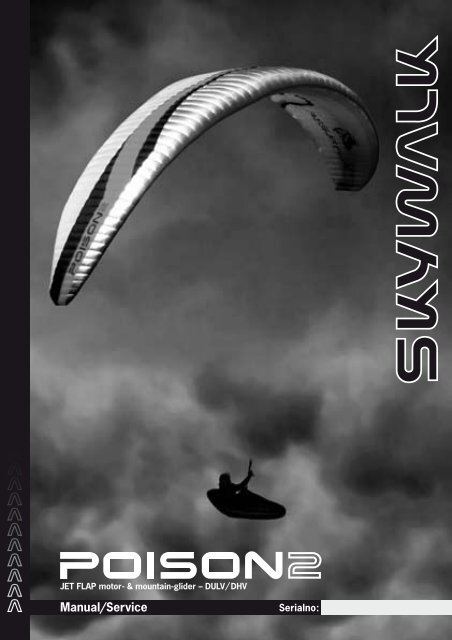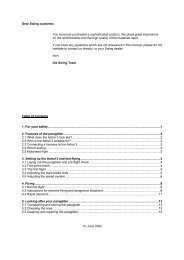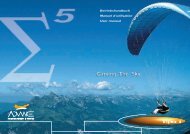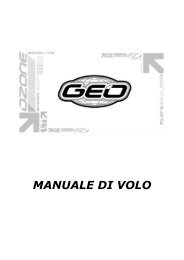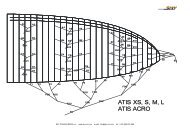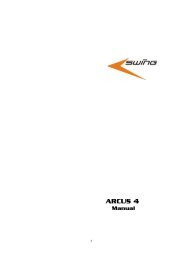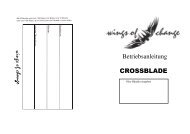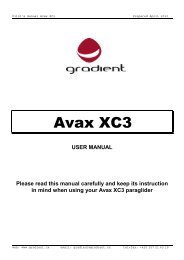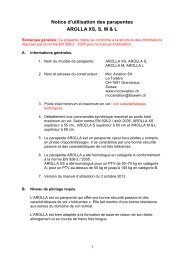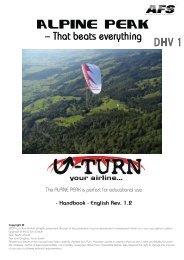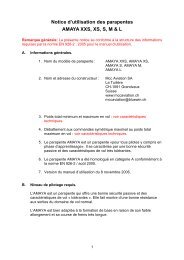Poison2 - Free
Poison2 - Free
Poison2 - Free
Create successful ePaper yourself
Turn your PDF publications into a flip-book with our unique Google optimized e-Paper software.
Manual/Service33
ContentIntroduction page 35Description, Technical data, Line system page 36Acceleration System page 39Harness page 40Flight Techniques and Characteristics page 41Descent Techniques page 45Extreme Flight Manoeuvres page 47Materials page 49Maintenance page 502-Year-Check / Certification page 53Conclusion page 54Line Plans, Risers page 55Test Protocols page 5934
IntroductionCongratulations and thank you for your decision for a skywalk glider! We can assureyou that this decision will be honored with plenty of joy in flying.To ensure that you feel at home on your new glider, we recommend you thoroughlyread the Owners Manual/Operating Instructions. This way you will get to know yourskywalk POISON 2 quickly and easily.The following instructions will help to maintain your skywalk POISON 2 in excellentcondition, to use it safely and have fun with it for a very long time.If you have any questions, remarks or suggestions for improvement,please don’t hesitate to contact us by fax, e-mail or phone.The skywalk-team will be happy to help anytime.Your skywalk-team35
DescriptionThe POISON 2 currently represents the absolute pinnacle of skywalk Paragliderdevelopment. The specifications for the successor to the well-established andsuccessful POISON 1 were manifold but clearly defined by our Test and CompetitionPilots and through ongoing customer feedback.The top requirement was to achieve maximal performance in Gütesiegel-certification.For experienced Pilots the first priority remains flyable performance, speed- above all,but without losing the solid climbing characteristics of the POISON 1. Naturally, aglider of this class retains the established JET FLAPS as part of the package.The POISON 2 speaks to the experienced cross-country and competition Pilot. With ourconstantly developing software, we’ve made large gains with the canopy quality, directlybenefiting the glide performance.Through a novel process called 3-D Ballooning, it is now possible for us to go into evenmore detail in the design of the canopy. The result- the canopy now exhibits extraordinaryperformance during high-speed flight as well as an above average stability.The POISON 2 sets a benchmark among lightweight Gliders, made possible by theworldwide debut of the novel cloth, Aerofabrix AL29, as well as with skytex27,manufactured by Porcher Marine.A sensationally low weight of approx. 5 kg is responsible for the amazingly manageableextreme flight characteristics, for a high performance glider with almost 70 cells.36
Technical DataType XS S M LNumber of cells 67 67 67 67Area [qm] 23,6 26,3 28,2 30Wingspan [m] 12,25 12,93 13,39 13,81Aspect ratio 6,36 6,36 6,36 6,36Area projected [qm] 19,5 21,7 23,28 24,8Wingspan projected [m] 9,41 9,92 10,28 10,61Aspect ratio projected 4,54 4,54 4,54 4,54linelength [cm] 692 740 756 780Line diameter [mm]0,5/0,7/0,8/0,9/1,25/1,4Cord max. [cm] 235 248 257 265Cord min. [cm] 52 55 57 59Canopy Weight [kg] 4,5 5,0 5,4 5,8Take off weight* [kg] 70-90 80-105 95-115 105-130Pilot + 17 kg equipmentThis paraglider meets the demands of the regulations of german hanggliding association,DHV and the CEN at the time of distribution.Further details of the construction and the measurements are described in the DHVtypesheet, which is part of this manual. The measurements of the line elements arelisted in the type sheet or in the lineplans. They are measured with 5 kg weight.The DHV measures from the line carabiner to the bottom sail.CAUTION:THE TYPE SHEET IS PRINTED ONTO THE INSIDE OF THE STABILO. DATE ANDNAME OF THE PILOT OF THE FIRST FLIGHT HAVE TO BE ENTERED!37
LinesystemThe POISON2 is equipped with a line system offering the ideal compromise betweendurability and low wind resistance. The material mix of sheathed Dyneema andunsheathed Tecnora lines guarantees the highest possible strength with minimal windresistance. The unsheathed Technora top lines as well as the main lines have low windresistance and high strength. They are partially double-spliced and additionally sewn.The double-splicing serves to optimally transfer power to the middle and top lines.To sum it up, this combination of materials offers both strength and performance.The skywalk POISON 2 has a real 3 Line System, which means it is composedof only 3 line levels. 3 A, 3 B, 3 C as well as 1 Stabilo Line.The skywalk POISON 2 has 5 Risers on each side.>> The innermost and second A-Lines lead to the A1-Riser.>> The outer A-Lines lead to the A2-Riser.>> The 3 B-Lines lead to the B-Riser.>> The outer C-Lines and the Stabilo Lines lead to the C1-Riser.>> The innermost and second C-Line lead to the C2-Riser.A schematical illustration of the Risers can be found on pageIMPORTANT SAFETY WARNING:Flying a paraglider require maximum caution at all times.Be aware that flying your paraglider is at your own risk. Asa pilot you have to guarantee the flying capability of yourparaglider before every single flight.Don’t use your skywalk POISON 2 :>> Outside the certified take-off weight.>> With motor.>> In rainy, snowy and extremely turbulent weather conditions or high winds.>> In fog or clouds.>> With insufficient experience or training.38
Every pilot is responsible for their own safety and will have to ensure that their aircraft(paraglider) has been checked and serviced for its airworthiness before flying.You can only fly your skywalk POISON 2 with a valid flying license and in accordancewith local rules and regulations.During its production your skywalk POISON 2 has passed thorough quality controlchecks.More spot checks were performed before its despatch.Acceleration SystemThe skywalk POISON 2 can be equipped with an enclosed foot operatedAcceleration-System.The Speed System acts on the A-, B- and C-Risers. In the Start position all Risers arethe same length: 50 cm without shackles. The P2 has a short and extremely effectivespeed path.By activation of the Speed System, the A-1 Riser will be shortened by 14 cm, the A2-Riser 10,3 cm, the B-Riser 9 cm, and the C1-Riser 5 cm. The C2-Riser retains its originallength. The brake-pulley moves upward during accelerated flight- this guaranteesthat the performance of the braking equipment under tension is not compromised. Optimalcanopy form is sustained during accelerated flight conditions as well. The SpeedSystem is designed for highest speed and best possible performance.CAUTION:THE DHV RATING OF SOME GLIDER SIZES CAN CHANGE DURING THE USE OFTHE ACCELERATION SYSTEM IN FLIGHT. TO DETERMINE WHICH SIZES AREAFFECTED PLEASE CHECK THE TYPE SHEET.39
Installing the accelerator equipment:Most commonly used harnesses have pulleys for the acceleration-system alreadyattached. The acceleration line runs from the front through the pulleys at the harnessto the top. They are tied to the ”Brummel-hooks” at the right length.With the right adjustment of the acceleration lines, the foot-bar can be reached easilywith angled legs during flight. By straightening the legs, the whole acceleration rangecan be used.Prior to flying, the connection hooks of the foot-operated accelerator and theacceleration-system have to be connected to each other (Brummel-hooks). Check thatthe acceleration line runs freely.Function:By using the foot-operated accelerator the pilot reduces the force via a pulleysystem byhalf and shortens the A-, B- and C- risers.HarnessThe skywalk POISON 2 is licensed for all certified harnesses of the GH type(harnesses without solid cross-bracing).Be aware that the level of suspension changes the relative braking distance.CAUTION:FULLY CROSS-BRACED HARNESSES EFFECT THE HANDLING DRASTICALLYAND DO NOT LEAD TO HIGHER SAFETY!40
Flight Techniques and CharacteristicsPreflight check and maintenanceIt is important to check all paragliding equipment thoroughly before every flight to seeif it has any defects. Also check the paraglider after long flights and after long storage.Check thoroughly:>> All seams of the harness, of the risers and of the reserve bridle.>> That all connecting parts, maillons and carabiners are closed.>> The brake-line knots on both sides and follow the brake-line to the top.>> All the other lines from riser to canopy.>> All the line attachment points at the canopy.>> If the top or bottom of the wing are damaged or perished.>> The ribs and crossports from inside.CAUTION:DO NOT Take-off IF YOU DETECT ANY DEFECTS, EVEN IF THEY ARE MINOR!If you find any damage or excessive wear and tear please get in touch with your flying school.The POISON is equipped with the trend-setting Jet-Flap system, just like the MESCALand TEQUILA. Air is conducted from the bottom sail (pressure area) to the top sail (lowpressurearea) and is blown out there with higher speed. The connection is establishedthrough jet shaped channels, which are located in the rear section of the wing.When increasing the angle of attack the danger of airflow interruption and subsequentstalling is minimized.Results: the constant airflow delays the stall even at great angles-of-attack, the flyableminimum speed is lowered and the pilot has a higher incidence range. This is of greatimportance, especially during starting and landing.The Jet-flaps help for an extraordinary climbing performance. You don‘t need anyspecial knowledge to have control of the flap system, the use of a Jet-Flap paraglider isthe same as a conventional glider.41
Accelerated Flying:You will notice the high performance of the <strong>Poison2</strong> not only during Trim flight, but alsoduring accelerated glide. When you activate the Speed System, avoid applying toomuch pressure- the system operates very effectively and directly. To reach the maximumspeed press the acceleration-system firmly until both pulleys on the A-riserstouch each other.If you apply pressure too quickly, the <strong>Poison2</strong> will dive down forward due to the extremechange in position. Brake with feel and the glider will quickly accelerate and therate of sink from start to highest speed will remain very moderate.We would like to stress that Pilots should fly only in wind conditions that they are accustomedto. Even though the <strong>Poison2</strong> is extremely stable in accelerated flight, a collapsein turbulence is still possible. In general, the reactions are more impulsive and demandquicker reaction time from the Pilot.Therefore always use the acceleration-system with adequate height above the ground,obstacles and other aircraft.During accelerated flight, the brake-pulley will move upwards, despite thisyou should avoid an inadequate brake-length line.NEVER ACCELERATE IN TURBULENT AIR!NEVER ACCELERATE NEAR THE GROUNDNEVER LET GO OF THE BRAKE HANDLES!In case the glider collapses you will have to release the acceleration-system immediatelyto stabilise and reopen your paraglider.Towing:The skywalk POISON is very suitable for towing.Make sure you climb from the ground at a flat angle.>> The pilot must have a valid towing license.>> The used tow winch has to be authorised.>> The winch operator must have a towing license, which includes paragliding.When towing always steer sensitively, do not brake too much because the glider alreadyflies at an increased angle of attack.stall the glider warily.43
Motorised flightTHE <strong>Poison2</strong> is not certified for Motorflight.Carefully packing your paraglider will increase the longevityof your glider.>> Empty the glider from all debris such as leaves, twigs, grass, sand etc.>> Sort out your lines and spread them evenly on the glider.>> Make sure the glider is dry when storing it for a longer period of time.>> Fold the glider starting in the middle and working your way to the outside alwaysfolding 2 cells, so that the leading edge is folded cleanly.>> Fold the cells, starting from the second cell from the middle, so that the reinforcededges of the cell openings are on top of each other.>> Do the same at the lower long-edge of the glider.>> This folding method is best done together with a friend, but you should be able todo the same on your own after some practice.>> Then press the air out of the folded glider starting at the bottom and working yourway to the top.>> Fold the whole row once toward the middle.>> Do exactly the same on the other side. Then fold one half onto the other half andmake sure the leading edge are folded cleanly.>> Start wrapping up the glider from its lower end. The wraps should be approx. 1ft.wide.>> The leading edge can be folded inwards once, but is not necessary. The left over airshould be pressed out of the glider and not through the material (this can increasethe porosity of your glider).>> Now attach the compression band around the packed wing, at right angles to thecell openings, then slide the glider into the light nylon bag. This helps to protect thecloth from being damaged by sharp edges or zippers from your harness.>> Open the bagpack and place your glider on the inside edge. The soft wing on yourback will make transportation much more comfortable.Place the harness with the seat board facing up on top of your glider and closethe zippers. Put the rest of your equipment (helmet, overall, instruments etc.) under thehood of your Packsack.44
Descent TechniquesThe POISON 2 MANUAL is not a textbook for learning how to paraglide.According to the local rules and regulations, instruction and training must be carriedout in licensed schools. The following information enables you to get the mostout of your skywalk POISON 2 .Spiral dive:You can initiate the spiral dive by carefully increasing the pull on one of the brakesand simultaneously shifting your weight to the inside of the turn. If the glider doesn’tbank up and the sink rate doesn’t increase, then try again. Don’t just apply more andmore brake without sensitivity.The skywalk POISON 2 enters the spiral dive with a high bank angle and makes a faststeep turn. The banking and sinking can be controlled by dosed pulling resp. looseningthe inner brakeline. Smooth braking of the outer wingtip avoids collapsing and alsospeed can be controlled better in hard spirals. The spiral is the most effective tool inloosing height. This is advantage and disadvantage at the same time, the pilot needs tobe able to handle the resulting high sinkrates.CAUTION:THE HIGH SINK RATE CAUSES HIGH PHYSICAL STRAIN DUE TO THEINCREASING CENTRIFUGAL FORCES AND MAY CAUSE BLACKOUTS!Tensing the stomach muscles during the spiral dive can be helpful. At the first signsof dizziness or feeling faint exit the spiral dive immediately.Because of the extreme loss of altitude experienced during a spiral dive always ensureyou have enough height above ground.To avoid a strong surge when exiting the spiral dive you have to release the insidebrake while applying the outer brake slightly.45
The skywalk POISON 2 has no tendency for locking into a spiral dive unless the Pilotsits with his weight on the inner side of the curve and does not sit in a neutral positionin the harness. In this case shift your weight to the outside of the turn and simultaneouslyapply more outside brake.Applying both brakes will also take the paraglider out of the spiral dive but the glidercan front tuck and you should dampen the exit with the brakes.Remember: Compared to regular flight manoeuvres the steering forces in aspiral dive are a lot higher!B-line stallB-Line Stall: Due to the 3 Line System, the B-Stall demands a higher energy expenditureas with the 4 Line Systems. The glider dives back further and shoots (at the wrongtime) clearly more forward. Because the B-Stall has a much higher wear and tear effecton the cloth, we recommend using it only as an aid in descending.Big earsBig Ears: Pull the outer A-Lines (A2-Riser) symetrically downward for Big Ears. Bothwing tips will fold inwards and the rate of sink increases.If you then activate the Speed System, the rate of sink will increase again. The gliderremains controllable through weight shift and braking on one side. To exit Big Ears,gently use the steering lines.A steep spiral or wingover with Big Ears is strongly discouraged. It can lead to damageof material due to the high stress on the remaining lines.46
Extreme Flight ManoeuvresCaution: all extreme manoevers place an extensive stress on materials. A reducedproduct life is the direct result.Asymetric tuck:In strong turbulence, the canopy may collapse. The skywalk POISON 2 will re-openautomatically even after bigger collapses within a turn of 180º. The turning towards thecollapsed wing section can be minimised by braking on the remaining open side of thecanopy. In case of a big collapse you will have to use small brake movements in orderto avoid a stall. In case the canopy still doesn’t recover you can accelerate the openingprocess by pumping the brake on the tucked side.Cravat/Line over:This type of instability never occurred during any of our test flights with the skywalkPOISON 2 . Still, in extremely turbulent air or during exceptional piloting errors it is possiblethat the folded wing section might get tangled in the lines.The pilot may then stabilisethe paraglider by careful counter-braking. Without immediate intervention of thepilot a cravated paraglider will turn into a strong spiral dive.There are several possibilities to untangle the paraglider:>> Pumping on the folded side.>> Pulling the stabilo-lines (tip-lines).>> In case none of these manoeuvres have any success you can try to unfold theparaglider by performing a Full Stall. Only experienced pilots, with a lot of flight experienceshould attempt this manoeuvre.CAUTION:IF NONE OF THESE MANOEUVRES ARE SUCCESSFUL OR THE PILOT FEELSOVERWHELMED BY THE SITUATION THE RESERVE PARAcHUTE SHOULD BEDEPLOYED IMMEDIATELY!Front tuck:The paraglider can be front tucked by a strong pull on the A-risers or whenencountering strong sink. The leading edge will fold forward along the whole length47
of the wing. Light braking will reduce the forward surge and will help to speed up theopening of the canopy. If the Pilot grabs the brakes too roughly, a dangerous stallcould result.The parachutal stall:The paraglider has no forward speed and a much increased descent rate.The Parachutal Stall may follow a too passively released B-line Stall.Porous canopy fabric (excessive UV-degradation) or frequent, strong towing(stretched A-lines) results in an increased risk of a Parachutal Stall.The pilot can recover from the Parachutal Stall by slightly pushing the A-risersforward at the mallions or by using the accelerator.The skywalk POISON 2 usually exits the Parachutal Stall automatically.CAUTION:AS SOON AS YOU APPLY THE BRAKES DURING A PARACHUTAL STALLTHE PARAGLIDER WILL IMMEDIATELY ENTER A FULL STALL. IF STILL INA PARACHUTAL STALL CLOSE TO THE GROUND DO NOT ATTEMPT TORECOVER BUT STRAIGHTEN UP YOUR POSITION IN THE HARNESS ANDPREPARE FOR A PARACHUTE LANDING ROLL.Wingover:Alternating left/right turns lead to an increased banking of the canopy. The load onthe outside wing tip to a minimum (the tip starts to feel light). Further turns and higherbanking is not recommended at this stage as the canopy might collapse on the insidewing section. To pick up speed brake gently to dampen the forward surge of the skywalkPOISON 2 and to counteract a possible Front Tuck.CAUTION:FULL STALL, NEGATIVE SPIN AND WINGOVERS (ABOVE 90°) ARE ILLEGALACROBATIC FLIGHT MANOEUVRES AND ARE NOT PERMITTED IN REGULARAIR TRAFFIC.WRONG OR EXCESSIVE STEERING IN THESE SITUATIONS MAY HAVE FATALCONSEQUENCES INDEPENDENT OF THE TYPE OF PARAGLIDER USED!48
MaterialsThe skywalk POISON 2 is manufactured out of highest-grade materials.skywalk has chosen the best possible combination of materials regarding durability,performance and longevity. We know that durability is a deciding factor for thecustomer’s satisfaction.Wing and Ribs:Leading Edge Upper Sail aerofabríx[AI] 29Bottom SailPorcher Marine 9017E68ALower Sail Porcher Marine skytex 27RibsPorcher Marine NylonLines:Top- and Brake-lines Edelrid 8000-80,8000-65,8000-45particially double splicedMiddle-lines Edelrid 8000-120, 8000-80particially double splicedMain-lines AI, AII, BI, BII Liros PPSL200,Main-lines AIII, BIII, CI, CII, CIII Liros TC 200 double splicedStabilo Edelrid 8000-80Main-Brake-lines Liros PPSL 200Leading edge reinforcements DacronAttachment point reinforcements DacronRisers:Risers are manufactured by Cousin Freres, from 12,5 mm Polyester webbing withKevlar inserts. Stretch values, strength and stability of this material is amongst theleading positions of all webbing products currently on the market.49
MaintenanceWith proper maintenance, your skywalk POISON 2 will be in an airworthy condition forseveral years. A well looked after paraglider lasts a lot longer than one which is packedin its bag without care after use. Always remember: Your life depends on yourparaglider! Furthermore, the POISON 2 is equipped with the new aerofabríx[AI] 29.Please read the Tips and Tricks for Cloth Handling.Storage:Store your paraglider in a dry location, protected from light and away from chemicals!Damp is a natural enemy for any paraglider. Therefore always make sure your paraglidingequipment is dry before packing it away. Dry if necessary in a heated room.Cleaning:Rubbing and cleaning leads to faster deterioration of your paraglider. The PU andAluminium-coated cloth of the skywalk POISON2 is highly soil-resistant. If you still thinkthat your paraglider needs to be cleaned, then use a soft and wet towel or sponge.Don’t use any soap or detergents. Never use inflammable products.Repair:All repairs must be carried out by the manufacturer or by an authorised skywalk-Service-Centre.Amateur repairs can cause more harm than good.Wear:The skywalk POISON 2 mainly consists of Nylon fabric that loses strength and showsan increase in porosity under the influence of UV-radiation. Only unfold the paraglidershortly before starting and pack away immediately after landing to avoid anyunnecessary sun exposure.Line-Repairs:The lines of the skywalk POISON 2 consist of a Dyneema-core and a Polyester-cover.Avoid heavy loads on single lines, as excessive stretch may be irreversible. The POI-SON2 suspension lines are composed of a Dyneema-core with a Polyester sheathingas well as unsheathed Technora LinesRepeated folding or kinking of lines at the same spot reduces their strength even if50
it’s just a little. A repeated pinching or folding of the line at the same spot diminishesits strength.Every visual damage of a line, even if it is only the line coating, requires a replacement.Only acquire new lines from the manufacturer or from an authorised skywalk-Service-Centre. Your flying school or your dealer will assist you to change a defect line.Check the correct length of the line before replacing it. Compare with its counterparton the opposite side of your glider. After the exchange a line-check will be necessary.The best way to this is by unfolding the glider on the ground!Tips and Tricks for Cloth Handling:aerofabríx[AI] 29 is metallized with mist-fine nano-coatings of aluminium, in order toreflect UV rays, and therefore markedly slow down the aging properties of the cloth.In order to care for and ensure the continued performance of your Glider and thisspecial high-performance cloth, it is imperative that you adhere to the following guidelines.Therefore, the following Instructions for Handling and Care:1. Avoid any unnecessary exposure to sun or weathering. During start, do not lay theglider on the ground for long periods of time, and always pack it up right after landing.2. Any rubbing or abrasion will lead to cloth damage, so be sure not to drag the clothon the ground.3. Lay the glider cell upon cell, but please avoid tightly squeezing or tightly folding theglider together.4. Always use the special inner Pack Sack together with the padded Pack Band, bothmade of very soft cloth.5. Always store the risers in the protective casing provided for this use.6. Never bring the cloth into contact with saltwater, the metallic content may react with the saltwater and lead to corrosion. If the glider does happen to come into contact with saltwater, please rinse it with ample amounts of fresh water andthen carefully and thoroughly dry it.51
7. Never pack up a wet glider! If this is unavoidable, then dry the glider as soon aspossible.8. After flying in air with a saltwater content, allow the glider to dry thoroughly –do not pack it up when still damp.9. If you do not fly with your glider for long periods of time, we recommend storing itin the special storage bag from skywalk. Store in a dry and low-light location.10. Never leave the glider in a car parked in full sun. The high temperature can lead tothe damage of any glider.11. Dirt or dust can be wiped away easily with a soft cloth and some warm water.Afterwards please dry thoroughly.12. You can repair small cracks as usual with Ripstop sealing tape, larger damagemust be repaired by an authorized Dealer.General informations:>> When unfolding the paraglider insure that neither the canopy nor the lines becometoo dirty as dirt particles in the fibres can damage the material and lines.>> If the lines get tangled on the ground they may be over-stretched or break duringtake-off.>> Do not step on the lines and/or canopy.>> Make sure that no sand, stones or snow get inside the canopy as the extra weightcollected in the trailing edge may slow down or even stall the glider.>> Sharp edges damage the canopy.>> Uncontrolled inflation attempts in strong winds may result in the glider impactinginto the ground at high speed. This can cause rips, damage on lines and/or fabric.>> Make sure not to land your canopy leading edge first as this may cause permanentdamage to this area of your paraglider.>> After landings in trees or on water you should check the length of the lines.>> After contact with salt water thoroughly rinse the equipment with fresh water!52
2-Year-Check / CertificationAccording to DHV regulations your glider will have to undergo a maintenancecheck after 24 months.According to these regulations the Two-Year-Check has to be carried outby the manufacturer, its representative or by the owner himself.The check will have to be confirmed by a DHV-stamp. Missing this deadline orif the check is carried out by an unauthorised company will lead to immediate lossof your skywalk POISON 2 DHV-certificate and all warranty and liability claims.We recommend not to do this check yourself. Without the proper instruments andspecific knowledge the check will be insufficient. The airworthiness of your glidercan’t be guaranteed.Changes to the paraglider:Your skywalk POISON 2 is manufactured within the regulated parameters of tolerance.These parameters are very narrow and mustn’t be altered under any circumstance.Only this way the optimum balance between performance, handling and safetycan be guaranteed!UNAUTHORISED CHANGES CAUSE AN IMMEDIATE EXPIRATION OF THEOPERATING LICENSE! ANY LIABILITY CLAIM TOWARDS THE MANUFACTURERAND ITS DEALERS IS EXCLUDED!53
ConclusionParagliding is a fascinating sport. With the POISON 2 you own a productwhich is at the top of actual developmentThis glider will provide you with plenty of fun over many years, as long as you treatand maintain it in a responsible way. Respect for the requirements and potential hazardsof our sport are essential for save and successful flying.Even the safest paraglider may crash due to a pilot error or meteorological miscalculations.Remember that aviation sports are potentially hazardous and that you are responsiblefor your own safety.In the interest of our sport we advise you to fly cautiously and in accordance with airlaw and local rules and regulations.PILOTS FLY AT THEIR OWN RISK!Your skywalk TeamGmbH & Co. KG54Bahnhofstraße 11083224 GRASSAUGERMANYFon: +49 (0) 8641 -6948 40Fax: +49 (0) 8641 - 69 48 11www.skywalk.infoinfo@skywalk.info
Line planThe displayed line plan of the skywalk MOJITO.HY is only for demonstration purposes ofthe line configuration. Plans for other sizes can be aquired via flight schools,importers or directly from skywalk.A2 (AIII)A1 (AI, AII)B (BI, BII, BIII)C1 (CIII, S)C2 (CI, CII)MAINBRAKEAIIIAIIAIa1a2a3a4 a5BIBIIBIIIb1b2b3b4b5CIIISCIICIc1 c2 c3 c4c5br1br2 br3 br4 br5br6BRINT 3BRINT 1 BRINT 2BRAKE IBRAKE IIBRAKE IIIA1B1C1br7br8A2B2C2br9a6a7b6b7c6 c7BRINT 4br10br11A3A4a8a9B3 B4b8b9C3C4c8c9br12br13br14BRINT 5a10a11b10b11c10 c11br15br16BRINT 6S1S2S3br1755
RiserPOISON Risers 2, Size XSPOISON 2, Size XS und S480 mmAIAIIBCI CIICII:480 mmB:390 mmA I:340 mmCI:435 mmA II:372 mmTrimspeedAccelerated56
RiserPOISON 2, Size Risers MPOISON 2, Size M500 mmAIAIIBCI CIICII:500 mmB:410 mmA I:360 mmCI:450 mmA II:397 mmTrimspeedAccelerated57
RiserPOISON RISERs 2, Size LPOISON 2, SIze L525 mmAIAIIBCI CIICII:525 mmB:426 mmA I:375 mmCI:475 mmA II:411 mmTrimspeedAccelerated58
Test ProtocoLtest ProtocolCustomer, Name:Adress:Phone:Date:Glider:Size: Serial number:Gütesiegelnr. Date of last check:Date of first flight: Year of construction:accomplished checking: Results: [ +/– ] Description of failure Suggested repairsIdentification:+ –visual check of canopy:Upper surface:Lower surface:Profiles:Line flares:Leading edge:Trailing edge:Crossports:+ –+ –+ –+ –+ –+ –+ –visual check of lines:Seams:Abrasion spots:Core withdrawals:+ –+ –+ –vis. check of connectionparts:Suspension line screw locks:Risers:+ –+ –lenght measurement:Risers:Lines:+ –+ –examinations of the canopy:Firmness of canopy:Porosity:+ –+ –59
examinations of the lines:Firmness of main lines: daNvisual check of trimming:+ –checkflight necessary?+ –Gütesiegel plaque?+ –Identification plate?+ –condition: NewVery good conditionGood conditionWell usedHeavily used, but within gütesiegel standards, frequent checks requiredNo longer airworthy, outside of the limit values.repairs made?Signature of tester: Date:60
Test ProtocoLtest ProtocolCustomer, Name:Adress:Phone:Date:Glider:Size: Serial number:Gütesiegelnr. Date of last check:Date of first flight: Year of construction:accomplished checking: Results: [ +/– ] Description of failure Suggested repairsIdentification:+ –visual check of canopy:Upper surface:Lower surface:Profiles:Line flares:Leading edge:Trailing edge:Crossports:+ –+ –+ –+ –+ –+ –+ –visual check of lines:Seams:Abrasion spots:Core withdrawals:+ –+ –+ –vis. check of connectionparts:Suspension line screw locks:Risers:+ –+ –lenght measurement:Risers:Lines:+ –+ –examinations of the canopy:Firmness of canopy:Porosity:+ –+ –61
examinations of the lines:Firmness of main lines: daNvisual check of trimming:+ –checkflight necessary?+ –Gütesiegel plaque?+ –Identification plate?+ –condition: NewVery good conditionGood conditionWell usedHeavily used, but within gütesiegel standards, frequent checks requiredNo longer airworthy, outside of the limit values.repairs made?Signature of tester: Date:62
GmbH & Co. KGBahnhofstraße 11083224 GRASSAUGERMANYFon: +49 (0) 8641 -6948 40Fax: +49 (0) 8641 - 69 48 11www.skywalk.infoinfo@skywalk.info


